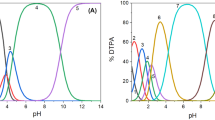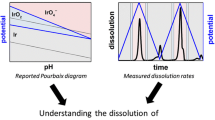Abstract
The transient response mechanism of the platinum electrode to the uncoupled ions may be interpreted with the mixed phase formation (MPF) model of the transient response of precipitate-based ion-selective electrodes to interfering ions for Kxy ≪ 1. It is discovered that the peak height of the transient signal is related to the solubility of M(OH)2 and hydration heat of M2+. The relation between the positive peak height of transient signal of pb2+ or cd2+ and lgam obey the Nernst equation, while that of Ca2+ or Mg2+ does not. The equilibrium potential is not of Nernst response for all ions.
Similar content being viewed by others
References
Hulanicki, A., Lewenstam. A., Model for treatment of selectivity coefficients for solid-state ion-selective electrodes,Anal. Chem., 1981, 53(9): 1401.
Lindner, E., Tóth, K., Pungor, E., Dynamic response of precipitate-based ion-selective electrodes in the presence of interfering ions,Anal. Chem., 1982, 54(2): 202.
Morf, W. E., Time-dependent selective behavior and dynamic response of silver halide membrane electrodes to interfering ions,Anal. Chem., 1983, 55(7): 1165.
Gratzl, M., Lindner, E., Pungor, E., Theoretical interpretation of transient signals obtained with precipitate-based ion-selective electrodes in the presence of interfering ions,Anal. Chem., 1985, 57(8): 1506.
Lewenstam, A., Hulanicki, A., Sokalski, T., Response mechanism of solid-state ion-selective electrodes in the presence of interfering ions,Anal. Chem., 1987, 59(11): 1539.
Berube, T. R., Buck, R. P., Lindner. E.et al., Comparison of proposed response mechanisms of precipitate-based ion-selective electrodes in the presence of interfering ions,Anal. Chem., 1989, 61(5): 453.
Gao Hong, Oscillographic Titration (in Chinese), Nanjing: Nanjing University Press, 1990, 433–450, 521-530.
Petrakovich, V. E., Oxidized-platinum electrode in electrometric analysis,Zh. Analit. Khim., 1963,18(10): 1161.
Doležal, J., Štulik, K., The use of platinum and carbon indicator electrodes in acid-base titrations,J. Electmnal. Chem., 1968, 17: 87.
Antropov, L. I.,Theoretical Electrochemistry, 2nd ed., translated from Russian by Beknazarov. A., Moscow: Mr Publishers, 1977, 159.
Dobos, D.,Electrochemical Data, A Handbook for Electrochemists in Industry and Universities, Amsterdam-Oxford-New York: Elsevier Scientific Publishing Company, 1975, 88: 99.
Gan Lanruo,Inorganic Chemistry (2) (in Chinese). 2nd. ed., Nanjing: Jiangsu Science and Technology Press, 1985, 22.
Lindner, E., Toth, K., Pungor, E.et al., Switched wall jet for dynamic response measurements,Anal. am., 1987, 59 (17): 2213.
Author information
Authors and Affiliations
Additional information
Project supported by the National Natural Science Foundation of China.
Rights and permissions
About this article
Cite this article
Shi, S., Yu, S. & Liu, P. Response mechanism of platinum electrode to uncoupled ions(I). Sc. China Ser. B-Chem. 40, 37–44 (1997). https://doi.org/10.1007/BF02882186
Received:
Issue Date:
DOI: https://doi.org/10.1007/BF02882186




